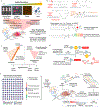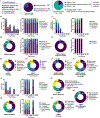Enhancing RNA-lipid nanoparticle delivery: Organ- and cell-specificity and barcoding strategies
- PMID: 39179112
- PMCID: PMC11972657
- DOI: 10.1016/j.jconrel.2024.08.030
Enhancing RNA-lipid nanoparticle delivery: Organ- and cell-specificity and barcoding strategies
Abstract
Recent advancements in RNA therapeutics highlight the critical need for precision gene delivery systems that target specific organs and cells. Lipid nanoparticles (LNPs) have emerged as key vectors in delivering mRNA and siRNA, offering protection against enzymatic degradation, enabling targeted delivery and cellular uptake, and facilitating RNA cargo release into the cytosol. This review discusses the development and optimization of organ- and cell-specific LNPs, focusing on their design, mechanisms of action, and therapeutic applications. We explore innovations such as DNA/RNA barcoding, which facilitates high-throughput screening and precise adjustments in formulations. We address major challenges, including improving endosomal escape, minimizing off-target effects, and enhancing delivery efficiencies. Notable clinical trials and recent FDA approvals illustrate the practical applications and future potential of LNP-based RNA therapies. Our findings suggest that while considerable progress has been made, continued research is essential to resolve existing limitations and bridge the gap between preclinical and clinical evaluation of the safety and efficacy of RNA therapeutics. This review highlights the dynamic progress in LNP research. It outlines a roadmap for future advancements in RNA-based precision medicine.
Keywords: DNA barcoding; Gene delivery; Lipid carriers; Personalized medicine; RNA therapies; Site-specific.
Copyright © 2024 The Authors. Published by Elsevier B.V. All rights reserved.
Conflict of interest statement
Declaration of competing interest The authors declare that they have no known competing financial interests or personal relationships that could have appeared to influence the work reported in this paper.
Figures







Similar articles
-
Developing Biodegradable Lipid Nanoparticles for Intracellular mRNA Delivery and Genome Editing.Acc Chem Res. 2021 Nov 2;54(21):4001-4011. doi: 10.1021/acs.accounts.1c00500. Epub 2021 Oct 20. Acc Chem Res. 2021. PMID: 34668716 Review.
-
Navigating the intricate in-vivo journey of lipid nanoparticles tailored for the targeted delivery of RNA therapeutics: a quality-by-design approach.J Nanobiotechnology. 2024 Nov 14;22(1):710. doi: 10.1186/s12951-024-02972-w. J Nanobiotechnology. 2024. PMID: 39543630 Free PMC article. Review.
-
Quantitation of physiological and biochemical barriers to siRNA liver delivery via lipid nanoparticle platform.Mol Pharm. 2014 May 5;11(5):1424-34. doi: 10.1021/mp400584h. Epub 2014 Apr 1. Mol Pharm. 2014. PMID: 24588618
-
Lipid nanoparticles for targeted siRNA delivery - going from bench to bedside.Int J Nanomedicine. 2016 Jul 5;11:3077-86. doi: 10.2147/IJN.S106625. eCollection 2016. Int J Nanomedicine. 2016. PMID: 27462152 Free PMC article. Review.
-
Advances in Lipid Nanoparticle-Based Disease Treatment.ChemMedChem. 2025 May 5;20(9):e202400938. doi: 10.1002/cmdc.202400938. Epub 2025 Feb 17. ChemMedChem. 2025. PMID: 39962990 Review.
Cited by
-
mRNA vaccines for gastrointestinal cancers: a paradigm shift in treatment.Naunyn Schmiedebergs Arch Pharmacol. 2025 Aug 6. doi: 10.1007/s00210-025-04462-8. Online ahead of print. Naunyn Schmiedebergs Arch Pharmacol. 2025. PMID: 40767872
-
Emerging therapeutic strategies for Wnt-dependent colon cancer targeting macropinocytosis.Cells Dev. 2024 Dec;180:203974. doi: 10.1016/j.cdev.2024.203974. Epub 2024 Nov 9. Cells Dev. 2024. PMID: 39528157 Review.
-
Advancing CNS Therapeutics: Enhancing Neurological Disorders with Nanoparticle-Based Gene and Enzyme Replacement Therapies.Int J Nanomedicine. 2025 Feb 4;20:1443-1490. doi: 10.2147/IJN.S457393. eCollection 2025. Int J Nanomedicine. 2025. PMID: 39925682 Free PMC article. Review.
-
Treatment of Acute Liver Injury through Selective Tropism of High Mobility Group Box 1 Gene-Silenced Large Peritoneal Macrophages.ACS Nano. 2025 Apr 1;19(12):12102-12118. doi: 10.1021/acsnano.4c18345. Epub 2025 Mar 18. ACS Nano. 2025. PMID: 40099379 Free PMC article.
-
Functions and mechanisms of lncRNAs in immune escape and their application in immunotherapy for colorectal cancer.J Transl Med. 2025 Jun 19;23(1):689. doi: 10.1186/s12967-025-06732-8. J Transl Med. 2025. PMID: 40537762 Free PMC article. Review.
References
-
- Polack FP, Thomas SJ, Kitchin N, Absalon J, Gurtman A, Lockhart S, Perez JL, Pérez Marc G, Moreira ED, Zerbini C, Bailey R, Swanson KA, Roychoudhury S, Koury K, Li P, Kalina WV, Cooper D, Frenck RW, Hammitt LL, Türeci Ö, Nell H, Schaefer A, Ünal S, Tresnan DB, Mather S, Dormitzer PR, Şahin U, Jansen KU, Gruber WC, Safety and efficacy of the BNT162b2 mRNA Covid-19 vaccine, New England Journal of Medicine 383 (2020) 2603–2615. - PMC - PubMed
-
- Baden LR, El Sahly HM, Essink B, Kotloff K, Frey S, Novak R, Diemert D, Spector SA, Rouphael N, Creech CB, McGettigan J, Khetan S, Segall N, Solis J, Brosz A, Fierro C, Schwartz H, Neuzil K, Corey L, Gilbert P, Janes H, Follmann D, Marovich M, Mascola J, Polakowski L, Ledgerwood J, Graham BS, Bennett H, Pajon R, Knightly C, Leav B, Deng W, Zhou H, Han S, Ivarsson M, Miller J, Zaks T, Efficacy and safety of the mRNA-1273 SARS-CoV-2 vaccine, New England Journal of Medicine 384 (2020) 403–416. - PMC - PubMed
Publication types
MeSH terms
Substances
Grants and funding
LinkOut - more resources
Full Text Sources
Miscellaneous

